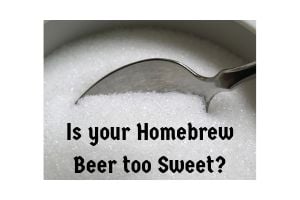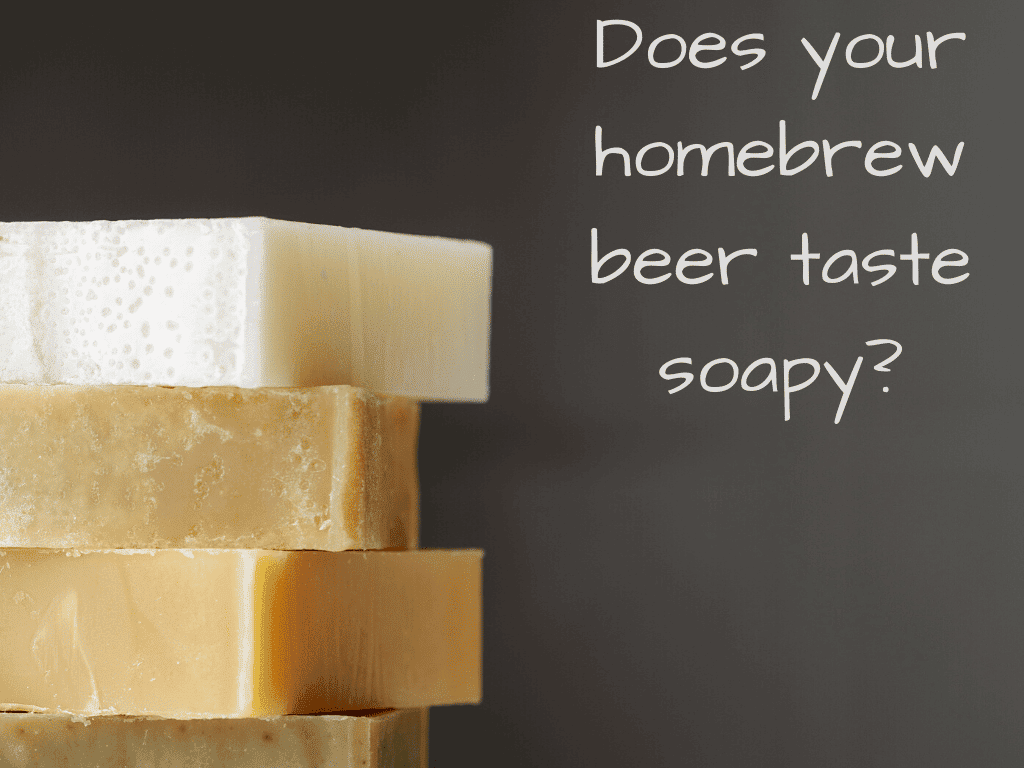Most new homebrewers choose to do an extract recipe for their first few batches and many discover that their extract homebrew beer has a strange twang or off-flavor to the taste.
Homebrew beer twang is common but difficult to describe off-flavor that often affects new homebrewers using extract beer kits. While there is some link between LME (Liquid Malt Extract) and homebrew beer twang it is more likely that poor brewing technique during the boil and fermentation are causing the off-flavor to develop.
It should come as no surprise that a new homebrewer will make mistakes and instead of focusing on the weak link between extract itself causing homebrew beer twang we will look closer at using proper techniques to avoid the flavor altogether.
Topics We Cover
What is homebrew beer twang?
Homebrew beer twang can be difficult to describe because it can take different forms depending on the underlying cause.
Since new homebrewers are more likely to deal with homebrew twang, there is also a good chance that they won’t be able to describe the taste very well due to their lack of experience.
Homebrew beer twang can be described as caramel, banana, green apples, cidery, astringent, or even skunky. While all of these are used to describe the ‘homebrew twang’ they can all separately be traced to specific brewing issues.
Because homebrew twang is used so loosely, it can be a real pain to narrow down what is actually happening with a twangy batch of beer.
Extract beer twang
I already mentioned that extract beer is notorious for having a twang in the finished beer but where did the reputation come from?
If you check out homebrewing forums you will see countless posts from new brewers that are struggling with off flavors in their beers and many responses will conclude that the extract malt used in the recipe is the culprit and that all-grain brewing will get rid of the issue.
This reasoning doesn’t really hold up, however, once you realize that many homebrewing competitions have been won by extract brewers over the years. Clearly, the underlying issue must have more to do with a new brewer’s experience level rather than the ingredients they are using.
So if the extract itself isn’t the issue, why do fewer all-grain brewers seem to have an issue with twang?
All-grain beer twang
Just because it is less common to find all-grain brewers complaining about homebrew twang doesn’t mean that it doesn’t exist.
In fact, I’ve seen many brewers posting that they made the jump to all-grain brewing to get rid of the ‘extract beer twang’ they have been dealing with only to discover that they are still dealing with the issue.
This is further evidence that it is a flaw in their system or poor technique that causing the twang in their finished beer rather than the extract ingredients themselves.
Whatever the reason, you are here because you want to know how to get rid of the twang so let’s dive in!
How to get rid of extract twang
As mentioned before, homebrew twang is a strange off flavor because it really hides behind many masks in the sense that the taste you are chasing could be caused by any number of technical errors.
Since nobody can really give a definitive answer about how to get rid of homebrew twang, let’s briefly go through the list of possible culprits so you’ll know what to change for your next batch!
The first two items on the list DO have something to do with extract malt itself so we’ll start there.
Use fresh, high-quality extract
If you check out enough homebrewing forums you will see that many brewers have traced their homebrew twang back to old, improperly stored, or poor quality liquid malt extract.
While it might seem like a no-brainer to use fresh ingredients, the relatively short shelf life of liquid malt extract means it can be difficult to use up within the expiration date if you can’t brew very often. That also means that homebrew supply stores might also have a hard time selling old stock before they bring in fresh extract.
You can see the potential issue here.
The most common sign that LME isn’t very fresh is that it will be darker in color than normal. If you receive a product like this from an online retailer then you might want to contact them to see if anything can be done.
Once you have the LME home, there are a few other things that you can do to keep it fresh until you brew:
- Make sure that the expiration date has not
- Check to ensure that the product seal is in place before storage
- Keep it stored at room temperature (or lower)
- Schedule your brew day as quickly as possible
The next step addresses the issue with liquid malt extract specifically
Switch from LME to DME or make the jump to all-grain
For various reasons, it’s commonly understood that liquid malt extract is a fair bit more perishable than dry malt extract and should therefore hold up better to improper storage methods and age.
Switching from liquid to dry malt extract could help reduce issues with homebrew twang if you are struggling with poor quality products from your homebrew supply store.
With that said, you will still need to properly check and store your DME the same as LME to ensure that it remains fresh for brew day!
Use reverse-osmosis or spring water
Water quality and mineral content is a big part of advanced beer brewing. In fact, learning how to test and alter your brewing water could really be a whole masterclass in and of itself.
Without going too far down the rabbit hole I will just say that making sure your brewing water isn’t bad is much more important than trying to make it better. The easiest way to do this is to simply purchase reverse-osmosis or spring water to use on brew day.
If you have typically just filled up your brew kettle with tap water on brew day then the quality of your water could be a culprit behind your homebrew twang because of a heavy chlorine content or other undesirable chemicals, metals, or compounds.
Once you become a hardcore brewer you can think about setting up a reverse-osmosis filter in your workspace to avoid having to buy water all of the time.
Don’t let your wort scorch during the boil
All-grain brewers follow a precise process to extract all of the fermentable sugars from the grains before they start the boil and the sugars are pretty well dissolved into the water beforehand.
Extract brewing, on the other hand, uses liquid malt extract that is poured into the water during the boil which can easily cause a big problem: scorching and caramelization of the extract.
When you mix the LME into the boil you have to be VERY careful about adding it slowly and stirring it constantly to avoid it sinking to the bottom of the kettle and settling against the heating element.
If your extract scorches or caramelizes it will reduce the amount of fermentable sugars and your wort but leave the sweetness of the sugar. This causes a beer that:
- tastes sweeter due to the residual sugar content
- has less alcohol content due to less fermentable sugar
- has a darker color
- includes a burnt off-flavor in addition to the sweetness
Overall, this is an easy mistake to correct as long as you are paying attention!
Use a yeast starter
Yeast health and proper fermentation are a BIG DEAL in homebrewing beer and many new homebrewers don’t pay enough attention to this step.
It is easy to wrap up your boil and simply toss the packet of yeast into the fermenter and while it can work perfectly fine it could also cause problems with stressed yeast.
You DO NOT want to stress your yeast. Stressed yeast equals bad beer.
Whether you are brewing with dry yeast or a liquid yeast pack, your fermentation will benefit from creating a yeast starter to ensure that there are enough active yeast cells to start the process quickly.
Luckily, it is super easy to make a yeast starter with just a flask, a few yeast nutrients, and a little wort. Heck, you can even buy cans of fastpitch wort to use for your yeast starters now – what a time to be alive!
Anyway, here is a great example of a basic yeast
Control your fermentation temperatures
Another big deal in homebrewing is fermentation temperature and the infamous homebrew twang could be attributed allowing a beer to ferment at too high of a temperature.
All yeast has a preferred fermenting temperature and it is up to the homebrewer to ensure that the beer stays within that range throughout the fermentation process.
Unfortunately, most new homebrewers don’t have a system in place to control or even monitor those temperatures so they think simply making sure the room their beer is fermenting in is within the temperature range is good enough.
Unfortunately, fermenting beer can actually be 10-15 warmer than the ambient temperature of the room during the peak of fermentation without proper temp control.
While fermentation chambers work great, new homebrewers can use the tried and tested cooler method to keep their fermenter at the right temp. Here is how you do it:
- Grab a cooler large enough to sit your fermenter inside with space all around. A bathtub could also work (if you don’t plan on using it!)
- Fill the cooler halfway with water.
- Place the fermenter into the water bath.
- Put a shirt or towel over the fermenter so that the water soaks up and makes contact with the fermenter.
- In a warm room, add a couple of small ice packs to the water bath.
With this setup, much of the excess heat will be drawn out of the fermenter and into the water bath, keeping your beer at a lower temperature.
Ensure your beer finishes fermenting
Another common issue with new homebrewers is a lack of patience.
For most recipes, you should expect to let your beer stay inside the primary fermenter for at least 2 weeks while some styles can benefit from up to 6 weeks.
Don’t be fooled when the fermentation process settles down and you stop seeing bubbles come out of the airlock after a few days. Trust me, the fermentation is still happening and you need to give those yeasties enough time to clean up after themselves and clear out of the beer.
Always take hydrometer readings before fermentation starts and then wait for the final gravity to settle for at least three days before you consider the fermentation complete.
Also note that taking a beer out of the fermenter too early and bottling it can result in bottle bombs!
Give your beer more time to condition
Similar to fermentation, conditioning requires patience as well.
Most new homebrewers are likely to be bottle conditioning and while the carbonation process can occur fairly quickly, it is generally recommended to let your beer condition inside the bottle for at least two weeks before you start chilling them and drinking.
Most simple ales and hoppy IPAs are best enjoyed as soon as their ready but more complicated styles can benefit from some extended bottle conditioning time.
Use better sanitization
I know you think your sanitization process is on point but it is so easy to make mistakes in this area, even for experienced brewers.
If you are having issues with homebrew twang, especially if it is a recent phenomenon then you should take a good hard look at your cleaning process.
Make sure that you have a quality homebrewing sanitizer (like Star San) in your work area and that you are taking apart all of your equipment completely to clean after each brew day.
Don’t forget that brewing equipment can get dirty in between brews and that anything that touches your beer AFTER the boil must be sanitized or you risk infection.




